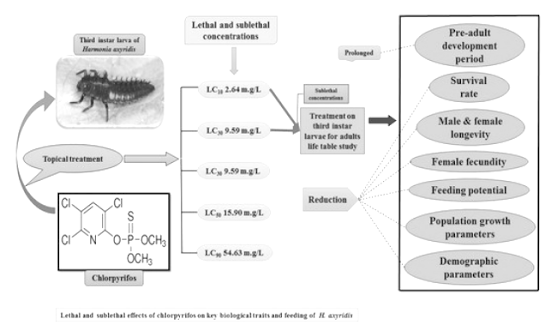BIOCHEMISTRY
RABIA IRSHAD WRITER
INSECTS REPELLENT
REPELLENT ACTION
MECHANISM
___
Medicascientist.com
INTRODUCTION
Amongst the greatest major mosquitoes stimulants are CO2, lactic acid, epidermis a substance epidermal warmth, includes wetness. Insect approaches to humans by using the warmth as well as humid convection's coming from the humans bodies like a guide. Mosquitoes repellents' activity may be classified into two categories: action on their smell senses and action on their tactile senses (Mahltig et al., 2023).
The value of the functions of the repelling is known as transpiration repellent. It prevents insects from landing on a repellent-treated surfaces. Through blocking the functions of detecting the moisture, repellent properties blocks the moisture-sensing detecting pores of the insects, rendering people unavailable to insects. The effect of the repelled activating the sensation of contact is known as immediate repulsion, which pushes insect away from the area that has been treated preceding bloodsucking, regardless of whether its surface is touched. Repellent chemicals are thought to function on the nerves in the peripheral systems found in insect (Nguyen et al., 2023).
Interaction induces an adjacently manifested confusional condition subsequent inhibitory with sublethal dosages prior to knockdown or lethal action. Determining whether repellents for insects function along with the way these compounds respond to odours might enable the development of possible mixtures which interference affect insect' sensory responses along with as a result, disturb the perception processes. A number of compounds have shown to be effective in repelling mosquitos (Andreazza et al., 2023)
Figure 1: Mode of action of insect repellent.
Lethal action
The method that occurs when the insect repellent's ingredient kills the insects is known as the deadly mechanisms of repelling actions. Insects-repellents, upon the other hand, are normally not intended to kill insects, instead attempting to repel them and keep them away from attacking or settling on the area being treated surfaces (Elsayed et al., 2022).
The insect repellents work by interfering affecting the sensory systems of insects, causing them to lose their capacity to find a host that is appropriate. Most repellents are substances function by forming a material obstacle through which insect are unable to penetrate, whereas other kinds work by modifying chemical messages that insect utilise to find an acceptable home. In either situation, repellent properties interferes with the insect's capability to find as well as feed on the person it is attacking, leading it to flee (Santana et al., 2022).
While most repellents for insects aren't meant to be fatal to insects, certain pesticides are manufactured like repellents are substances therefore are potentially lethal to insect. Insect repellent kill insect through attacking the nervous system as well as various critical processes. Nevertheless, using pesticides as insect repellents may lead to significant adverse environmental effects as well as is typically never suggested until essential for insect population reduction (Bandi et al., 2023).
Insect repellents can additionally function through disguising the host's aroma and appeal that attracts the insects. The following is often performed through offering a disagreeable smell that repels the insects or through producing a competitive enticing odour which overpowers the aroma provided by the hosts (Mangang et al., 2022).
Its lethal method of actions is frequently linked with insecticide instead of repellents that attract insects. The insecticides have the purpose of eliminating insect through attacking certain physiologic and biochemical systems, which include their nervous systems and metabolic. The insecticides may be utilised for controlling populations of insects in a range of situations, from fields of agriculture to initiatives aimed at improving public health. Yet, the use of these substances may result in significant environmental consequences, and therefore they ought to be utilised sparingly with caution and prudence (Coetzee et al., 2022).
In most cases, repellents that work are intended to keep insect form attacking and settling on a treated surfaces instead of killing insects. Since a consequence, they are a more secure, more ecologically friendly alternatives to pesticides. repellents for insects may be utilised in a range of situations, ranging from outdoors enjoyment to initiatives aimed at improving public health, therefore may serve as an efficient means of lowering the possibility of insects-borne illnesses while also increasing the general standard of existence (Dade et al., 2023).
The efficiency of repellents for insects may differ based on a variety of variables, such as the species of insect that is being targeted, the dosage of the repellent that worked including the time that they are exposed to the medicated surfaces. Furthermore, certain creatures might develop resistant to particular insect repellents as time passes, reducing their efficacy (Mota Filho et al., 2022).
To maximize the efficacy of repellents that repel insects, it is critical that you adhere to the directions provided by the manufacturer and employ them as directed in combination with other precautions including carrying insect repellent clothing and staying away from places that have significant insects population (Briozo et al., 2022).
A repellent for insects finishing constitute a significant and highly effective way of guarding towards insects-borne illnesses as well as improving the general standard of existence, especially in insect-infested locations. Although they aren't usually intended to be harmful to insects in particular, they do operate through interference with their capacity to identify and feed on an insect host, which means that they might be a more ecologically friendly alternatives to pesticides. Insect-repelling coatings, when used properly as well as combination with additional precautions, might offer efficient protections versus insects-borne illnesses while contributing to a healthier and more pleasurable outdoors experience (Nagai et al., 2022).



Post a Comment